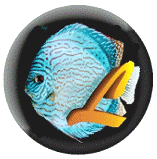
One of the things that many Aquarists dread...MOVING. I recently accepted a new position for the company I work for. I was exited for the opportunity, but when I sat down and thought about the move, the first question I asked my wife was, "How are we going to move all these fish tanks?" I was mostly concerned with my Discus tank.
Luckily, my wife had just purchased a new 125g tank for my birthday and I had not yet transferred my Discus to this tank. I was able to have the movers pack this and deliver it to my new location while keeping my 55g up and running in my old location (I supervised the packing, loading, and unloading of this tank personally). Therefore, I was able to get my 125g up and running in my new location prior to going back to my old location to get the fish.
Here are the steps I took in moving my Discus and other fish.
First, I set my 125g tank up in the new location. I took some of the filter media from my existing 55g tank and some of the gravel from my 55g tank when I set the tank up to establish the biological cycle. After the tank was running a couple of days and the temperature was stabilized, I drove back to my old location to get the fish. The fish I needed to move into this tank included: 5 full grown Discus, 3 very large Clown Loaches, 1 Cardinal Tetra, 4 Otocinclus, and 7 Rasboras.
Next, the day prior to the move, I did a 30% water change in the tank. I also had not fed the fish for 24-48 hours. I would have preferred to do a 30% water change for 2 consecutive days prior to the move if my schedule would have permitted it. I half-filled a 5 gallon bucket with tank water, added a few plastic plants for cover, and netted all the Tetras, Rasboras, and Otos into the bucket. I put a squirt of Amquel in the bucket and put a lid on the bucket which had a small air hole in it.
For the Discus and Clown Loaches, I used extra large ziplock freezer bags. I half-filled a bag with tank water and then added a squirt of Amquel and 1 drop of Methylene Blue. I put one Discus or Clown Loach per bag and sealed the bag. I then put the first bag into the second bag and sealed that bag. Lastly, I put some newspaper around the double bag and inserted that into a third bag and sealed that. I did this for all 8 fish.
After the fish were triple bagged, I placed them in a cooler lined with bubble wrap and closed the cooler. I loaded the cooler and 5 gallon bucket into my car. Since it was November in northeastern U.S., the temperatures were below freezing. I wrapped the 5 gallon bucket in a large blanket. I also took more filter media and gravel from the 55 gallon tank just to be safe.
The drive was approximately 5 hours so the fish were in the bags for a total of 6-7 hours.
Upon arrival at the new location, I removed the bags from the cooler and floated them in the new tank. I then opened the bags added a small amount of water from the 125 gallon tank. I continued to add water about every 5 minutes for approximately 30 minutes. I was also adding water in small amounts to the bucket with the smaller fish in them. After 30 minutes, I released all the fish into the tank.
The fish showed very little stress and were eating again the very next day. I should mention, that the water conditions in my new location were vastly different than the old location. The old location had water of medium hardness and PH of 7.0. The new location had extremely hard water with a ph of greater than 8.0. Even with this difference, I did not lose a fish and the fish showed no signs of stress or disease. I eventually purchased an RO unit to get my water more suitable for Discus.
With my other tanks, I did not have the luxury of having separate tanks to be set up ahead of time. I followed the same procedures in moving the fish, but I had to do some additional work in moving the tanks at the same time. After removing the fish from a tank, I then drained all the water from the tank. I kept 5 gallons of the tank water in a bucket and also moved this. After the tank was empty, I loaded it into the car (gravel was still in tank) along with the fish, filters, etc..
Upon arriving at the new location, I set up the tank with the 5 gallons of water that I removed from the tank originally, and the rest from Tap water (adjusted to the right temperature). After the tank was set up, I used the same acclimation process as described above. Again, this method worked without a single loss.
As I sit here and type this, I am also watching my Discus (now 10) in my 125g tank. My assignment in this location is only a temporary one so I will need to move again in about a year. Although I know it will be a lot of work, I am not as worried about losing fish as I was the first time.